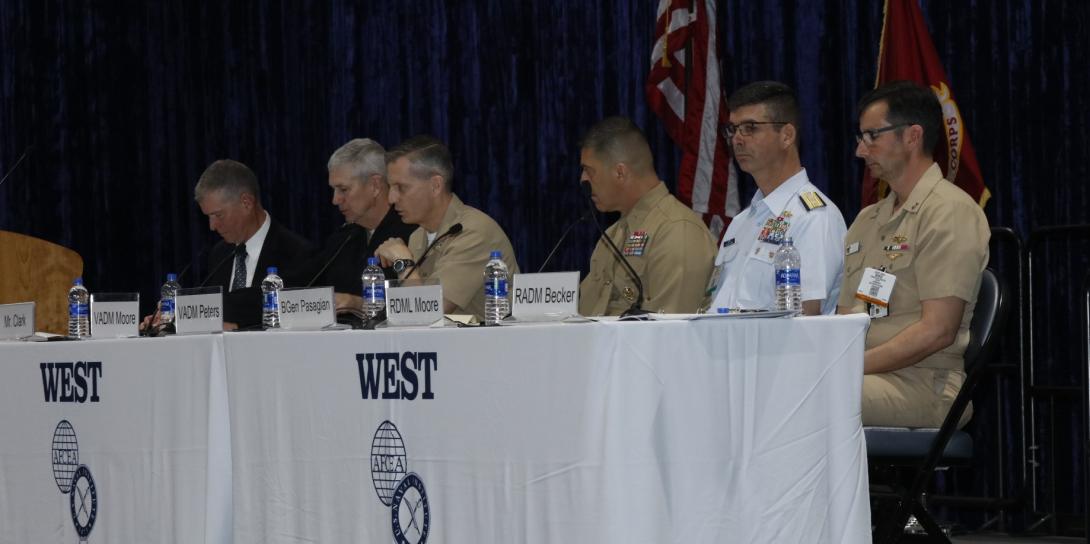Acquisition Wields Its Touch on Modernization
The U.S. Navy is exercising innovative ways of procurement to modernize its force to meet growing foreign threats. Acquisition alternatives may hold the key as the sea services gird for great power competition around the globe.
Just how the Navy, Marine Corps and Coast Guard set priorities amid a technological revolution was the focal point of a panel on the second day of WEST 2020, the conference and exposition in San Diego March 2-3 co-sponsored by AFCEA International and USNI. Flag officers from the three services discussed their greatest needs and innovative means of acquiring them.
“The tilt is definitely on modernization," pointed out Brig. Gen. Arthur J. Pasagian, USMC, commander, Marine Corps Systems Command. He noted that his command awarded 41 Other Transaction Authority (OTA) contracts, with half going to consortia.
The tilt is definitely on modernization.—Brig. Gen. Arthur J. Pasagian, USMC, commander, Marine Corps Systems Command @USMC #WEST2020
— Bob Ackerman (@rkackerman) March 3, 2020
Acquisition is not as much as an obstacle as people might assume, officers said. “The requirements definition process cannot be done in a vacuum,” offered Vice Adm. Thomas J. Moore, USN, commander, Naval Sea Systems Command. “It’s not broken, but it is a lot more complex than it was years ago.”
The requirements definition process cannot be done in a vacuum. It’s not broken, but it is a lot more complex than it was years ago. Vice Adm. Thomas J. Moore, USN, commander, Naval Sea Systems Command @NAVSEA #WEST2020
— Bob Ackerman (@rkackerman) March 3, 2020
And the key to meeting requirements is speed, said Vice Adm. G. Dean Peters, USN, commander, Naval Air Systems Command. He called for the ability to communicate requirements more effectively. Gen. Pasagian offered that the Navy and Marine Corps have never been in a better spot on requirements development.
It’s about being able to communicate the requirements more effectively.—Vice Adm. G. Dean Peters, USN, commander, Naval Air Systems Command @NAVAIRNews #WEST2020
— Bob Ackerman (@rkackerman) March 3, 2020
Integration is at the heart of this modernization, and Gen. Pasagian said that long-range fires in support of Marine Corps operations will benefit strongly from it. He added that the Corps also must interoperate with the U.S. Army when it moves inland from a shore landing. “There are vertical and horizontal aspects that you have to plan for,” he declared.
We interoperate with the Navy. But once ashore, we have an inescapable need to interoperate with the U.S. Army. There are vertical and horizontal aspects that you have to plan for.—Brig. Gen. Arthur J. Pasagian, USMC, commander, Marine Corps Systems Command @USMC #WEST2020
— Bob Ackerman (@rkackerman) March 3, 2020
The Coast Guard has a different set of acquisition challenges to meet the maritime threat. “We’re in the middle of the biggest recapitalization we’ve ever undergone,” said Rear Adm. Nathan Moore, USCG, assistant commandant for engineering and logistics. But the Coast Guard will still need to conduct missions with legacy gear. “We still have the really, really old 1960s and '70s ships,” he said, noting that this provides one advantage. “They’re really cyber hardened,” he said.
But we still have the really, really old 1960s and 70s ships. They’re really cyber hardened….—Rear Adm. Nathan Moore, USCG, assistant commandant for engineering and logistics @USCG #WEST2020
— Bob Ackerman (@rkackerman) March 3, 2020





Comments